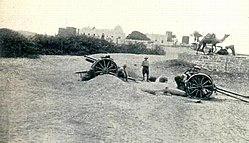| Ordnance QF 15-pounder Mk I | |
|---|---|
 QF 15-pounder Mk I with standard British wooden wheels, original axle-tree seats and no shield | |
| Type | Light field gun |
| Place of origin | German Empire |
| Service history | |
| In service | 1901–1916 |
| Used by | United Kingdom |
| Wars | World War I |
| Production history | |
| Designer | Heinrich Ehrhardt |
| Manufacturer | Rheinische Metallwaren und Maschinenfabrik |
| No. built | 108 [a] |
| Specifications | |
| Mass | Barrel & breech 737 lb (334 kg); Total 2,272 lb (1,031 kg) [1] |
| Barrel length | Bore 7 ft 2 in (2.2 m); Total 7 ft 6 in (2.3 m) [1] |
| Crew | 10 [1] |
| Shell | 76.2 x 169mm .R Separate loading QF. Shrapnel, 14 lb (6.4 kg) |
| Calibre | 3 in (76 mm) |
| Breech | single motion, tapered block with interrupted collars |
| Recoil | Hydro-spring, constant, 48 in (1.2 m) [1] |
| Carriage | wheeled, pole trail |
| Elevation | -5° – 16° |
| Traverse | 3° L & R |
| Rate of fire | 20 rds/min [2] |
| Muzzle velocity | 1,674 ft/s (510 m/s) [b] |
| Maximum firing range | 7,000 yd (6,400 m)? (percussion fuze) 6,600 yd (6,000 m) (time fuze) [3] |
The Ordnance QF 15-pounder gun, [c] commonly referred to as the Ehrhardt, was a modern German field gun purchased by Britain in 1900 as a stopgap measure to upgrade its field artillery to modern QF standards, while it developed its own alternative. This was precipitated by the experience of the British Army in South Africa during the Second Boer War, where its standard field gun, the BL 15-pounder, was out-performed by modern French and German field guns deployed by the Boers. It bore no relation to the BL 15-pounder or BLC 15-pounder, two other guns in British service at the time, other than a common shell.





